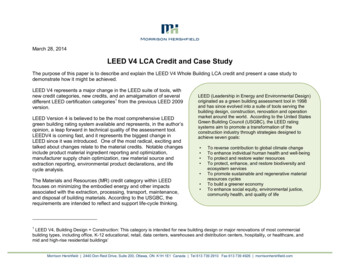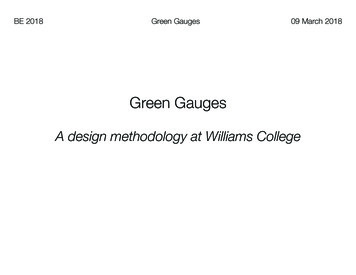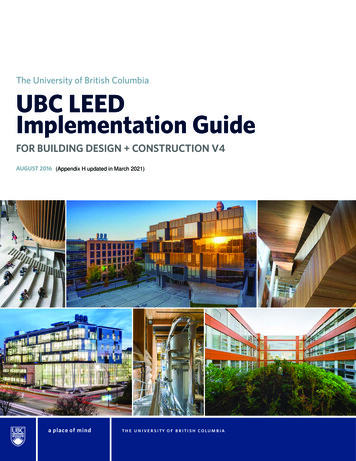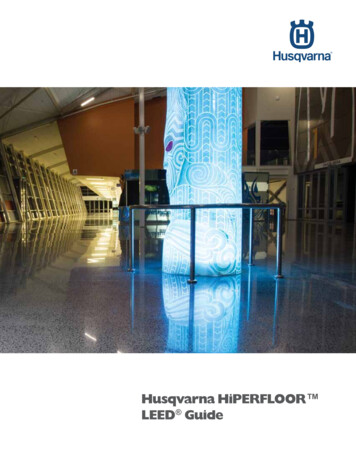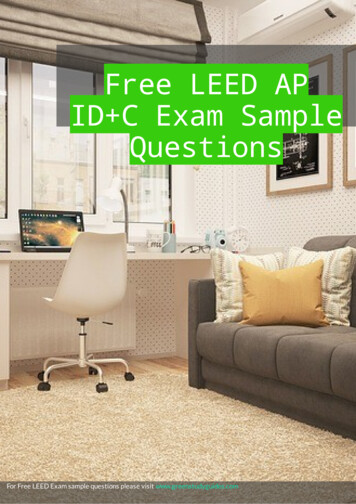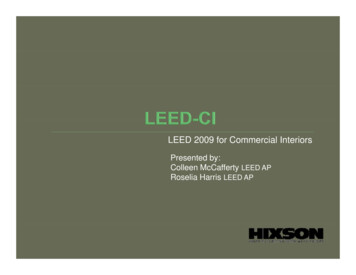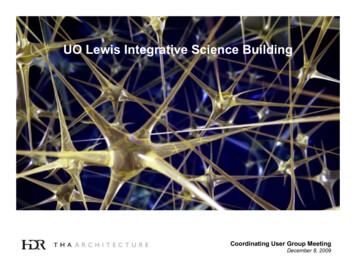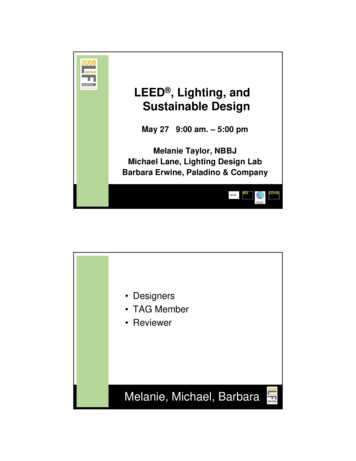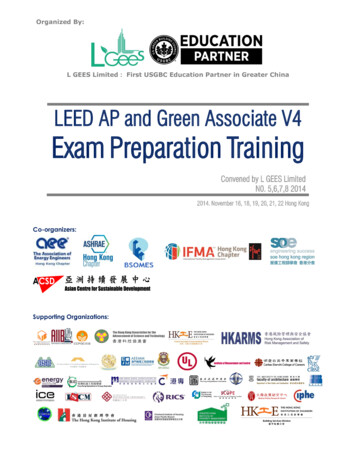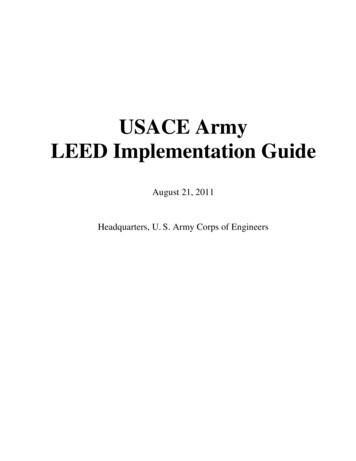
Transcription
USACE ArmyLEED Implementation GuideAugust 21, 2011Headquarters, U. S. Army Corps of Engineers
USACE Army LEED Implementation Guide21 August 2011Table of Contents:1. Purpose. 12. Applicability . 13. Background . 14. Army LEED Requirements . 15. LEED Responsibilities .46. Using the LEED-NC Rating Tool . 47. Relation of LEED to Federal and Army SDD Mandates . 68. LEED Certification . 69. Project Registration . 810. Project Documentation . 911. Government Validation . 1012. Reporting . 1113. Initial Project Programming/Planning Charrette. 1314. Code 3 Design/Parametric Estimating Using ENG Form 3086 . 1415. Design-Build (DB) Request for Proposal . 1516. Design . 1717. Construction . 1818. Army LEED-NC Credit Guidance and Resources . 1919. RFP Sample Text . 2120. Center of Standardization (COS) Multiple Contractor Projects. 2121. Training . 2122. Frequently Asked Questions (FAQs). 2123. Glossary . 2124. Waivers . 2125. LEED Registration of Army Projects . 21AppendicesA. Army LEED-NC Credit Guidance and ResourcesB. RFP Sample Text (Design/Build, Single Contractor)C. Center of Standardization (COS) Multiple Contractor ProjectsD. TrainingE. Frequently Asked Questions (FAQs)F. GlossaryG. WaiversH. LEED Registration of Army ProjectsI. USACE LEED Campus Project Requirements
USACE Army LEED Implementation Guide21 August 2011
USACE Army LEED Implementation Guide21 August 2011United States Army Corps of Engineer (USACE) Army Leadership Energy andEnvironmental Design (LEED) Implementation Guide1.Purpose. This implementation guidance is to assist USACE Project Delivery Teams (PDTs)meet the Army‟s LEED policy. Other federal and Army sustainable design and development (SDD)requirements are not addressed in this document.2.Applicability. This implementation guidance applies to USACE-executed new construction,renovation and demolition projects located on Army property. Paragraphs 5 through 16 addressesUSACE processes for implementing LEED and are applicable to all USACE projects requiringLEED. The Army requirements contained herein do not apply to USACE property for the civilworks program – HQUSACE will issue separate LEED requirements for these projects. Thisdocument incorporates all Army and USACE LEED guidance up to Engineering ConstructionBulletin (ECB) 2011-01 and Army 27 October 2010 SDD policy update, has been coordinated withand approved by Army Chief of Staff for Installation Management (ACSIM) and, in the case ofconflict, supersedes all previously issued Army and USACE Army LEED guidance. This documentincludes LEED documentation and interpretation guidance that reflects current guidance from GreenBuilding Certification Institute (GBCI) and United States Green Building Council (USGBC) as ofthe date of this publication. This document provides guidance (in parentheses) for Air Force (AF)projects. Be sure to check with the AF project manager (PM) for any updated information.3.Background. The Sustainable Project Rating Tool (SPiRiT) was implemented as theArmy‟s sustainable design rating tool in 2001. The USGBC Leadership in Energy andEnvironmental Design – New Construction (LEED-NC) rating tool replaced SPiRiT effective withthe FY 08 Military Construction Army (MCA) program, except Army Family Housing projects,which continue to be rated using SPiRiT through the fiscal year (FY) 12 program. Generally theterm “LEED” (without further designation), as used in this document, refers to LEED-NC. Forprojects rated using SPiRiT, references to “LEED” in this document should be substituted with“SPiRiT” (processes are the same), except discussion of LEED project registration and certificationis not applicable to SPiRiT projects. Links to the documents referred to in this guidance can befound at Appendix A, Army LEED-NC Credit Guidance and Resources. All civilian employees ofand uniformed members of the Army are full members of the USGBC and qualify for all memberdiscounts and benefits. See appendix E Frequently Asked Questions (FAQs) for more informationon membership.4.Army LEED Requirements.a. GENERAL. Except where indicated otherwise, these requirements apply worldwide to allfacility construction activities on permanent Active Army installations, Army Reserve, ArmyReadiness Centers, Army National Guard Facilities and Armed Forces Reserve Centers, regardlessof funding source and including Base Realignment and Closure (BRAC) and non-Army tenantfacilities on Army property. For tenant projects on Army property, USACE project Master Plannerand PM will make the tenant organization aware of Army LEED requirements and the tenantresponsibility to coordinate directly with the installation Department of Public Works (DPW) if therequirements cannot be met. These requirements apply to permanent facility construction only.1
USACE Army LEED Implementation Guide21 August 2011Excluded are overseas contingency construction and continental United States (CONUS) interimfacilities. However, overseas contingency construction and CONUS interim facilities shouldincorporate as many sustainability features as life cycle cost effective especially passivesustainability measures.b. APPLICABLE VERSION OF LEED-NC. Requirements apply regardless of which version ofLEED-NC is used to execute a project. Projects will be executed using the version of LEED underwhich they are registered.c. MINIMUM REQUIREMENT - NEW FACILITIES IN THE UNITED STATES AND ITSTERRITORIES. Starting with the FY08 program, all new facilities with mechanical climate-controlfor human comfort that were registered under LEED-NC v2.2 and all new facilities that meet theLEED-NC Minimum Program Requirements will achieve the LEED-NC SILVER level. Startingwith the FY13 program, all new facilities meeting the LEED-NC Minimum Program Requirementswill be certified at the Silver level by GBCI. See paragraph 17 for specific LEED credits that arerequired. These requirements do not apply to Army Family Housing; see paragraph 4e for ArmyFamily Housing requirements. (AF projects shall be certified at the LEED Silver level).d. MINIMUM REQUIREMENT – MAJOR RENOVATIONS IN THE UNITED STATES ANDITS TERRITORIES. Major renovations will meet the same requirement as new facilities. A majorrenovation is defined as follows:(a) For the FY08 through FY12 program: A project that BOTH exceeds the garrison commanderfunding approval authority (assume 7.5 million) AND has a repair to replacement ratio equal to orgreater than 25 percent. Note: Both UFC 3-701-07, Department of Defense (DoD) Facilities PricingGuide, and Department of Army (DA) Pamphlet 420-11, Project Definition and Work Classification,provide guidance for computing the facility replacement value.(b) For the FY13 program and beyond: Changes to a building that provide significantopportunities for substantial improvement in the sustainable design elements of the building,including energy efficiency OR any renovation that exceeds 7.5m.e. MINIMUM REQUIREMENT – NEW ARMY FAMILY HOUSING IN THE UNITED STATESAND ITS TERRITORIES. For the FY08 through FY12 program, all new Army Family Housingand homes built under the Residential Communities Initiative will achieve SPiRiT GOLD level. Forthe FY13 program and beyond, all new Army Family Housing and homes built under the ResidentialCommunities Initiative will achieve and be certified at the LEED for Homes Silver level unless theyachieve Energy Star Qualified New Homes or are designed to achieve energy consumption levels45% below the baseline set by IECC 2009. (Check with the AF for the correct accreditation systemto use for AF housing projects).f. MINIMUM REQUIREMENT – OTHER CONSTRUCTION IN THE UNITED STATES ANDITS TERRITORIES. Construction that does not meet the requirements of paragraphs c - e abovewill be scored using LEED-NC and incorporate sustainable design features to the maximum extentlife cycle cost effective technically possible, but will be exempt from the minimum LEED score thatapplies to new construction. Examples of this are horizontal construction (such as ranges, roads andairfields), buildings that do not meet LEED Minimum Program Requirements and renovation and2
USACE Army LEED Implementation Guide21 August 2011repair projects that do not meet the above definition for major renovation. Supportingdocumentation of achievement will be developed.g. USE OF OTHER RATING TOOLS IN THE UNITED STATES AND ITS TERRITORIES.Other green building rating tools may be substituted if demonstrated to achieve an equivalent levelof performance in sustainable design and if approved. For Army users a waiver is required perparagraph 4i, except a blanket waiver may be requested to allow the substitution on a wider basis.Waiver requests will include comparison data for the proposed substitution to demonstrateequivalent achievement. For tenant users on Army property, Installation concurrence is required perparagraph 4a. LEED for Schools, LEED for Healthcare and LEED for Retail Silver achievementlevel is considered equivalent to LEED-NC Silver achievement and may be substituted withoutpermissions. All projects that are approved to use another rating tool will develop supportingdocumentation of achievement in accordance with the approved rating tool requirements. (Checkwith the AF or other agency for use of other green building rating tools).h. MINIMUM REQUIREMENT – CONSTRUCTION LOCATED OUTSIDE THE UNITEDSTATES AND ITS TERRITORIES. All projects will strive to meet the requirements for projectslocated within the Unites States and its territories and to achieve an equivalent level of performancein sustainable design. Projects should meet LEED criteria and host nation criteria. Host nationcriteria and rating tools may be used. Supporting documentation of achievement will be developedby the geographic district. FY13 and beyond should refer to Assistant Secretary of the Army forInstallations, Energy and the Environment (ASA-IEE) Policy Memo 27 Oct 2010.i. FAILURE TO MEET REQUIREMENTS – ARMY USER. The LEED requirements areconsidered criteria. If the PDT determines that a project cannot meet any individual LEEDrequirement within funds available or due to adverse mission, security, antiterrorism/forceprotection, health, safety or welfare impacts, the PM will submit a waiver request per the proceduresin Appendix G. This will be done as soon as the failure is known, but no later than the nextPrescribed Reporting Point (paragraph 11b). Coordinate all Installation and User change requests toensure they do not cause the project to fail. If, at project completion, any LEED requirements thatdid not receive previous waiver approval are not achieved, the PM will prepare an After ActionReport and forward it to the Division/Major Support Command (MSC) SDD Program Manager,HQUSACE SDD Proponent, Regional Integration Team (RIT) Program Manager and theEngineering and Construction (E&C) cost engineering POC with an explanation as to why thisrequirement was not achieved. The PM will also ensure that lessons learned on LEED failure fromthe project are documented in the USACE Enterprise Lessons Learned (ELL) database. (Check withthe AF for guidance on submitting waiver requests if LEED criteria will not be met).j. FAILURE TO MEET REQUIREMENTS – NON-ARMY TENANT USER. If the PDTdetermines that a project cannot meet LEED requirements within funds available, due to adversemission, security, antiterrorism/force protection, health, safety or welfare impacts or if the tenantdoes not agree to the requirement (including requirement to certify), the PM will notify the tenantand facilitate the tenant‟s coordination to obtain installation concurrence. This will be done as soonas the failure is known, but no later than the next Prescribed Reporting Point (paragraph 11b). If, atproject completion, any LEED requirements (except those that installation concurrence for deviationwas obtained) are not achieved, the PM will prepare an After Action Report and forward it to theRegional Integration Team (RIT) Program Manager and the E&C cost engineering POC with an3
USACE Army LEED Implementation Guide21 August 2011explanation as to why this requirement was not achieved. The PM will also ensure that lessonslearned on LEED failure from the project are documented in the USACE Enterprise LessonsLearned (ELL) database. (Check with the AF for guidance on submitting waiver requests if LEEDcriteria will not be met).5.LEED Responsibilities.a. HQ USACE SDD POCs. Establish HQ USACE SDD policy and implementation guidance.Provide recommendations on waiver requests to other HQ USACE offices. Provide SDDtraining opportunities. Establish communication channels with MSC SDD POCs. Provideanswers to MSC SDD POC questions on policy. Provide answers to MSC SDD POC technicalquestions or direct MSC SDD POCs to centers of expertise. Collect results of MSC SDDprogram review quarterly and submit results to senior leadership. Serve as HQ USACEinterface to USGBC, GBCI and other service SDD points of contact. Represent HQ USACE ontri-service committees.b. MSC SDD POCs. Establish communication channels with District SDD POCs to communicateArmy and HQ USACE SDD policies, guidance and training opportunities to the districts and toprovide consolidated MSC and district input to HQ USACE. Establish any MSC SDD specificpolicy and guidance. Answer District SDD POC questions on policy and technical questions ordirect District SDD POCs to centers of expertise. Provide HQ USACE with list of MSC andDistrict SDD POCs quarterly. Provide HQ USACE with list of projects LEED certifiedquarterly. Review MSC program (or cause a review program to be put in place) to ensureprogram is complying with applicable sustainability and energy policies. Report results(numbers of projects certified and “certifiable” with reasons for not obtainingcertification/”certifiable” status and any general issues) quarterly to HQ USACE. Providetraining to MSC and district personnel as required.c. District SDD POCs. Establish communication channels within the district design andconstruction personnel to communicate Army and HQ USACE SDD policies, guidance andtraining opportunities and to provide consolidated district input to MSC SDD POCs. Answerdistrict personnel questions on policy and technical questions or direct personnel to centers ofexpertise. Provide MSC SDD POC with list of District POC quarterly. Provide MSC SDD POCwith list of projects LEED certified quarterly. Review district program to ensure program iscomplying with applicable sustainability and energy policies. Report results (number of projectscertified and “certifiable” with reasons for not btaining certification/”certifiable” status and anygeneral issues) quarterly to MSC SDD POC.6.Using the LEED-NC Rating Toola. SCORING PROJECTS WITH LEED. The LEED-NC rating system is for a building and its site.Some credits are claimed by the site development and some are claimed by the building. Where abuilding is indicated as required to achieve LEED Silver in the Requirements paragraph, it isassumed that the building and its site achieve that level together.b. LEED ACCREDITED PROFESSIONAL. An integrated design approach will be used and thePDT composition will reflect this approach. For a description of integrated design see EngineeringResearch and Development Center/Civil Engineer Research Lab (ERDC/CERL) TR-04-19, SPiRiT4
USACE Army LEED Implementation Guide21 August 2011Scoring Through Self-Assessment Charrettes. Each design team and each construction team willinclude a LEED Accredited Professional (LEED AP) as well as a geographic district LEED AP toreview project documents and provide advice. The LEED AP on the design and construction teamwill ensure correct interpretation of LEED requirements by the team, provide guidance andassistance to PDT members in developing suitable and complete documentation, ensure LEEDrequirements are incorporated in the work and ensure LEED documentation prepared by the team iscomplete and correct. See Appendix E FAQs for information on becoming a LEED AP.c. LEED INTERPRETATIONS AND ADDENDA DATABASE (formerly Credit InterpretationRequests). Registered project team members may submit inquiries to GBCI (contact GBCI for feesassociated with this service) if they have a question about application of a credit to their project.Prior to submitting an inquiry project teams are strongly encouraged to review the LEEDInterpretation database online at the USGBC website. USGBC provides this database to trackprecedent-seting rulings on formal inquiries that can be applied to multiple projects. This new systmreplaces the previous credit interpretation request (CIR) system. All posted CIRs from USGBC maybe applied to all LEED-NC v2.2 projects but are not applicable to LEED-NC 2009 projects.d. LEED INNOVATION & DESIGN (ID) CREDITS. LEED ID credits are acceptable for Armyprojects only when they are formally approved in writing by USGBC or GBCI (included in LEEDReference Guide, USGBC ID Credits Catalog or approved by CIR).e. LEED PROJECT BOUNDARY. For purposes of applying the LEED credit calculations a LEEDProject Boundary is established by the design team and all LEED documentation consistentlyobserves this boundary. The LEED Project Boundary does not have to match the limits ofconstruction and should exclude work that is unrelated to the building seeking LEED achievement.An example of work that is logically located outside the LEED Project Boundary for a building isroad improvements or utilities that extend well beyond the building site. Work that is outside theLEED Project Boundary is excluded from all LEED documentation. USGBC offers the USGBCguidelines for determining site boundaries athttp://www.usgbc.org/DisplayPage.aspx?CMSPageID 2102.f. CAMPUS PROJECTS (MULTIPLE BUILDINGS ON A SHARED SITE). When a projectincludes a single site with more than one building, each building will include the credits claimed bythe shared site in its LEED score. This is a campus application of LEED.(1) LEED APPLICATION GUIDE FOR MULTIPLE BUILDINGS AND ON-CAMPUSBUILDING PROJECTS. The LEED Application Guide for Multiple Buildings and On-CampusBuilding Projects (AGMBC), by USGBC, provides guidance on scoring and documentation forCampus projects. The AGMBC also provides alternative compliance paths that are uniquely suitedto an Army Installation environment, such as how to treat shared features such as consolidatedparking. It is a free download at usgbc.org. The LEED-NC AGMBC Projects dated October 2005,by USGBC, provides guidance applicable to v2.2 Campus projects. The 2010 LEED ApplicationGuide for Multiple Buildings and On-Campus Building Projects (2010 AGMBC), dated October 11,2010, and the 2011 LEED Application Guide for Multiple Buildings and On-Campus BuildingProjects (2011 AGMBC), to be published in 2011, by USGBC, together provide guidance applicableto LEED 2009 Campus projects.5
USACE Army LEED Implementation Guide21 August 2011(2) CAMPUS PROJECTS COORDINATION AND DOCUMENTATION. See Appendix I forspecial coordination and documentation requirements for Campus projects.g. CENTRAL ENERGY PLANTS. Follow current USGBC guidance. USGBC document“Treatment of District or Campus Thermal Energy in LEED V2 and LEED 2009 – Design &Construction” dated August 13, 2010, applies to v2.2 and LEED 2009 projects.7.Relation of LEED to Federal and Army SDD Mandates.a. GENERAL. Although they are similar to LEED, federal, DoD, Army and USACE sustainabledesign mandates are separate standalone requirements. Meeting the LEED requirements hereindoes not in itself constitute compliance with USACE, DoD, Army and federal sustainable designmandates. PDTs will first address compliance with these separate standalone requirements and thenselect LEED credits that contribute to compliance when possible. Implementation guidance forUSACE, DoD, Army and federal sustainable design mandates is outside the scope of this Guide.(Check with the AF for any AF criteria or guidance not included in DoD and federal sustainabledesign mandates.)b. FEDERAL ENERGY CONSERVATION MANDATE COMPLIANCE AND LEED OPTIMIZEENERGY POINTS CALCULATIONS. Army requires federal energy conservation mandatecompliance to be measured as a percentage reduction in annual building energy use that excludesprocess loads. The LEED 2009 Minimum Energy Performance prerequisite and Optimize Energycredit are based on percentage reduction in annual building energy cost that includes process loads.Thus, separate calculations for both the federal mandate and LEED compliance are required.c. ARMY WASTE DIVERSION MANDATE COMPLIANCE AND LEED CONSTRUCTIONWASTE MANAGEMENT CREDIT CALCULATIONS. Army waste diversion calculations includeall waste in the project but LEED waste diversion calculations are restricted to only the waste insidethe LEED Project or Campus Boundary. When the project scope includes work outside the LEEDProject or Campus Boundary, both must be provided separately. A USACE spreadsheet thataccommodates these differences is available for Contractor (optional) use athttp://en.sas.usace.army.mil/enweb.8.LEED Certificationa. GENERAL. LEED certification is accomplished by means of GBCI review of all project LEEDdocumentation and subsequent certification of the project score by GBCI. See www.gbci.org forproject certification procedures and fees. District personnel may submit projects for certification orcontracts may include a requirement for the Contractor to obtain LEED certification. Throughoutthe certification process the Designer of Record and Contractor may be requested to answerquestions from the GBCI review team and must remain available to support the certification processto achieve certification.b. REQUIRED LEED CERTIFICATIONS.(1) FY10 THROUGH FY12. The Army requires formal LEED certification of at least 5% of theclimate-controlled new buildings in each program year for FY10 through FY12. Guidance will beissued annually by HQUSACE on the selection of these buildings. If a project is selected for LEED6
USACE Army LEED Implementation Guide21 August 2011certification under this program, all associated fees for project registration and certification must bepaid from project funds. (The AF requires certification for all projects per AF/A7C memo AF SDDUpdated Guidance).(2) FY13 AND BEYOND. Starting with the FY13 program formal LEED certification isrequired as indicated in paragraph 4. All associated fees for project registration and certificationmust be paid from project funds.c. PDT LEED CERTIFICATION OPTION. PDTs may choose to seek LEED certification of anyproject using project funds as long as costs do not exceed the project Programmed Amount.Contract modifications to require certification may use contingency funds and should use ReasonCode 1 – ENGINEERING CHANGES if the change is generated by the PDT (not a designdeficiency) or Reason Code 4 – USER CHANGES, DISCRETIONARY if the change is generatedby the User, Installation or Army.d. DESIGN REVIEW. The GBCI certification process allows two options – a single certificationreview of all design and construction credits at the completion of construction OR a review of designcredits at the completion of design (GBCI design review) followed by a review of constructioncredits at the completion of construction. Each GBCI design review can take approximately threemonths. The benefit of the second option is a review early in the project.(1) Design-Bid Build (DBB) projects seeking certification will obtain GBCI design review atcompletion of final design. Design review is independent of and does not delay project solicitationor award.(2) Design-Build (DB) projects (DB Contractor is Designer of Record) seeking certification arenot required to obtain GBCI design review but it is recommended.e. CERTIFICATION AND PROJECT CLOSEOUT. Certification is applied for when constructionis substantially complete and this task should have no effect on BOD. Financial closeout ofcontracts that require certification cannot occur until certification ruling is obtained. GBCI does notrequire that post-occupancy credit activities be complete at the time of certification request but, ifcontract requirements, must be completed prior to project financial closeout.f. CERTIFYING CAMPUS PROJECTS. See 2010 AGMBC for more information.g. CERTIFICATION FEES. Fees for project certification may be paid from project design orconstruction funds. See www.gbci.org for project certification procedures and fees. Note thatLEED 2009 Campus projects have a different fee structure.h. OWNER AND CHANGE OF OWNER AT CERTIFICATION. The US Army is the owner (forthe AF, the US Air Force is the owner). The USACE geographic district PM will act as Owner‟srepresentative through project certification but cannot provide post-occupancy utility data, so theOwner designation at LEED Online must change at the time of certification. The USACE PM willbe designated Owner in LEED On-line up through certification. Immediately prior to acceptanceof GBCI certification ruling the Owner’s representative designation in LEED On-line must bechanged to the Installation DPW Director (for the AF the owner’s representative will bechanged to the Base Civil Engineer. For other agencies, check with that agency’s7
USACE Army LEED Implementation Guide21 August 2011organizational representative). The USACE geographic district PM is responsible for ensuringthis change in Owner designation occurs at the correct time.9.Project Registrationa. GENERAL. LEED project registration allows the PDT to use the LEED v2.2 Letter Templates or2009 Forms (preformatted credit documentation forms with built-in calculators) for projectdocumentation and to compile all LEED project data at LEED On-line. LEED Registration andcompilation of LEED project data at LEED On-line is required for all projects except those that donot meet the minimum program requirements. LEED registration is the only legal means to accessthe copyright-protected LEED Letter Templates/Forms. Downloaded LEED LetterTemplates/Forms may not be locally duplicated for use on unregistered projects. Sample LEEDLetter Templates/Forms are available for review only at the usgbc.org website.b. VERSION 2.2 LEED PROJECT REGISTRATION. All projects with a v2.2 LEED Silverachievement requirement must be registered, use the LEED Letter Templates for projectdocumentation and compile all project documentation at LEED On-line. As of June 2009 projectsmay no longer be registered under v2.2. The use of a single registration for Campus projects isallowable only for v2.2 projects and requires all buildings under the single registration to earnexactly the same credits.c. LEED 2009 PROJECT REGISTRATION. All buildings that meet the minimum programrequirements will be registered, use the LEED Forms for project documentation and compile allproject documentation at LEED On-line.(1) NUMBER OF REGISTRATIONS. LEED 2009 requires a separate registration for eachbuilding.(2) CAMPUS PROJECTS. For Campus projects a Block must be used and a separateregistration of the shared site is required. See the 2010 AGMBC for more information.(3) MINIMUM PROGRAM REQUIREMENTS. LEED 2009 requires compliance with LEEDMinimum Program Requirements (MPRs) to register any building. Do not register any building thatcannot meet all MPRs by design completion.(4) METHOD OF PROVIDING POST-OCCUPANCY UTILTY DATA. Registration in LEEDOnline requires selection of the method the Owner will use for providing utility data. All DoDentities are exempt from this requirement. If the DPW (or BCE) would like to provide thisinformation there are thr
document incorporates all Army and USACE LEED guidance up to Engineering Construction Bulletin (ECB) 2011-01 and Army 27 October 2010 SDD policy update, has been coordinated with and approved by Army Chief of Staff for Installation Management (ACSIM) and, in the case of conflict, supersedes all previously issued Army and USACE Army LEED guidance.

